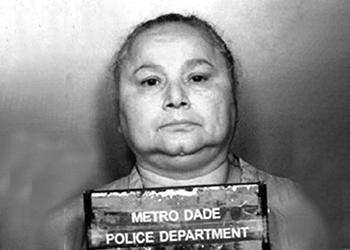Ana Griselda Blanco Restrepo was one of the pioneers of the cocaine trafficking pipeline from Colombia to the United States. As a key trafficker in the 1970s and 1980s, she played a leading role in the Miami drug wars of the period. Blanco was known as “La Madrina” (The Godmother) due to her alleged relationship with Pablo Escobar, and “La Viuda Negra” (The Black Widow) in reference to the deaths of three of her husbands.
Blanco is credited with several criminal innovations, including recruiting young men as human couriers, transporting drugs through airports, and using extreme violence to eliminate rivals.
History
Griselda Blanco was born in Santa Marta, a city on Colombia’s Caribbean coast, on February 15, 1943. In 1955, she moved to Medellín with her mother, Ana Lucía Restrepo. There, she launched her criminal career in the neighborhoods of Lovaina and Santísima Trinidad, robbing passers-by and the homes of wealthy people.
In Medellín, she met her first husband and the father of her first three children, Carlos Trujillo, who worked forging US documents and visas. Trujillo died of cirrhosis in the mid-1970s, but by that time Blanco had already met her lover and future second husband, Alberto Bravo. Together, they entered the international drug trafficking business.
The couple began by trafficking medical cocaine that was leftover from procedures at an exclusive clinic in Medellín and sold to them by two nurses, according to journalistic investigations. Using a front import-export business he ran with his brother, Carlos Bravo, Alberto was able to sell the cocaine for ten times its value in New York City.
As the potential of the cocaine market in the United States became clear, Blanco and Bravo devised new ways to expand their operations. They worked alongside partners such as José Antonio Cabrera Sarmiento, alias “Pepe Cabrera,” dubbed by US authorities as “the wings of the Medellín Cartel” due to his fleet of cargo planes, and the Ochoa Vásquez brothers (Jorge Luis, Juan David, and Fabio), co-founders of the Medellín Cartel.
By the early 1970s, the two had set up shop in Queens, New York, and were importing large quantities of cocaine and marijuana that were produced in Colombia, Peru, and Bolivia.
In October 1974, US authorities placed Blanco on its list of most wanted fugitives, making her a prime target of “Operation Banshee,” one of the US Drug Enforcement Agency’s first major operations. However, she was able to evade authorities by keeping on the move.
Blanco allegedly murdered her husband and partner Alberto Bravo and continued the business on her own. After marrying her third husband, Darío Sepúlveda, she expanded into Miami, leading to bloody confrontations with her competitors.
In early 1985, she was arrested in Irvine, California. Another 12 members of her organization were also detained in operations carried out in Panama, Colombia, and the United States. A judge sentenced her to 15 years in prison without bail.
In 1995, while Blanco was still serving her sentence, authorities charged her with three murders after hearing the testimony of one of her former hitmen, Jorge Ayala. Blanco pleaded guilty to the murders in 1998 in exchange for a reduced sentence. She was released and deported to Colombia in 2004.
Back in Medellín, Griselda Blanco led a quiet life for years. In 2012, two hitmen shot her dead outside a butcher shop in the Belén neighborhood.
Criminal Activities
Griselda Blanco was a hugely important actor in the expansion of cocaine trafficking from Colombia to the United States, pioneering trafficking routes and methods that defined the business for decades.
Blanco was responsible for organizing cocaine shipments that supplied the US cities of New York, Miami, San Francisco, and Los Angeles, as well as laundering the money obtained through the drug sales.
Human couriers hired by Blanco’s organization carried small quantities of cocaine through airports. They used false bottoms in suitcases and shoes, and also hid the drug in dog crates and underwear. Blanco also shipped larger quantities hidden on speedboats and other private vessels.
During its heyday of the early 1980s, Blanco’s organization trafficked 1.5 tons of cocaine to the United States each month. It also had its own group of hitmen known as the “Pistoleros” (Gunmen), who allegedly carried out the first point-blank motorcycle assassination. This assassination method subsequently became a hallmark of the Medellín Cartel.
Geography
Blanco’s drug trafficking operations – and their associated violence – were concentrated in Medellín, Colombia, and the US cities of New York, Miami, San Francisco, and Los Angeles.
Due to her constant movement, US authorities were unable to track Blanco down until the mid-1980s in California. Previous operations had unsuccessfully attempted to lure her to Costa Rica, where the United States had an extradition treaty.
Allies and Enemies
During the 1970s, Blanco was associated with notable Colombian drug trafficking figures, including Alberto Bravo, Carlos Lehder-Rivas, the Ochoa Vásquez brothers, and Pablo Escobar.
As Blanco expanded her empire, she battled numerous drug traffickers and even some of her own associates. She was known for her ruthlessness, ordering the killings of people with whom she had personal vendettas, who owed her money, or who were competing with her organization. She allegedly accused murdered her second husband, Alberto Bravo, who she accused of stealing part of her drug profits.
Blanco played a key role in a spike in homicides in Miami between rival groups seeking to control the cocaine market. In 1979, hitmen allegedly working for Blanco murdered Colombian trafficker Germán Jiménez Panesso in a store in Dadeland Mall, sparking a wave of related violence. This period would come to be known as the Miami drug wars.
Blanco’s high-profile role in the drug trade led to her having numerous enemies who pursued her and her family for years. In the early 1990s, hitmen murdered her eldest son, Jhon Oswaldo Trujillo Blanco, in a Medellín tavern. The killers remain unknown 20 years later.

